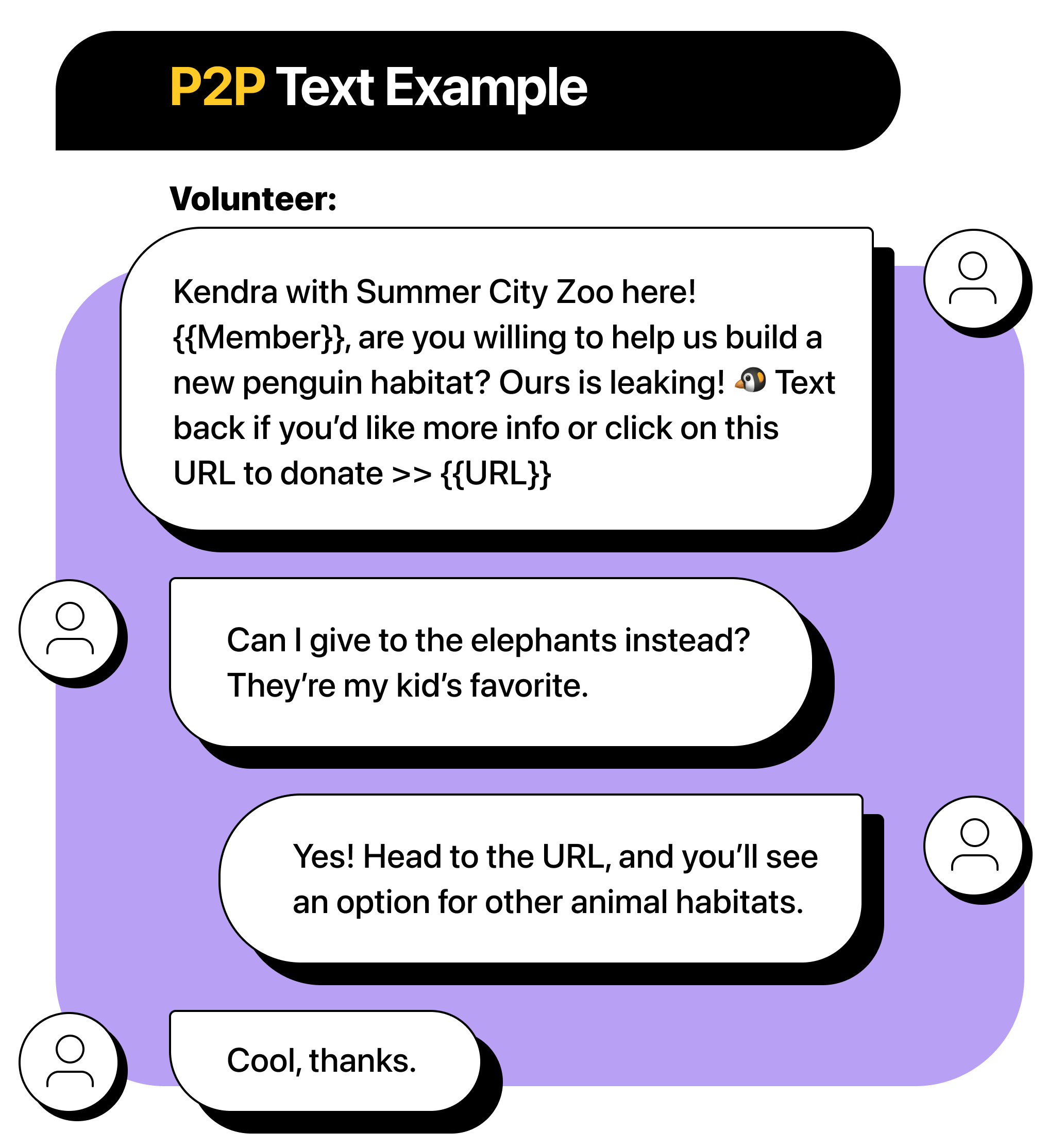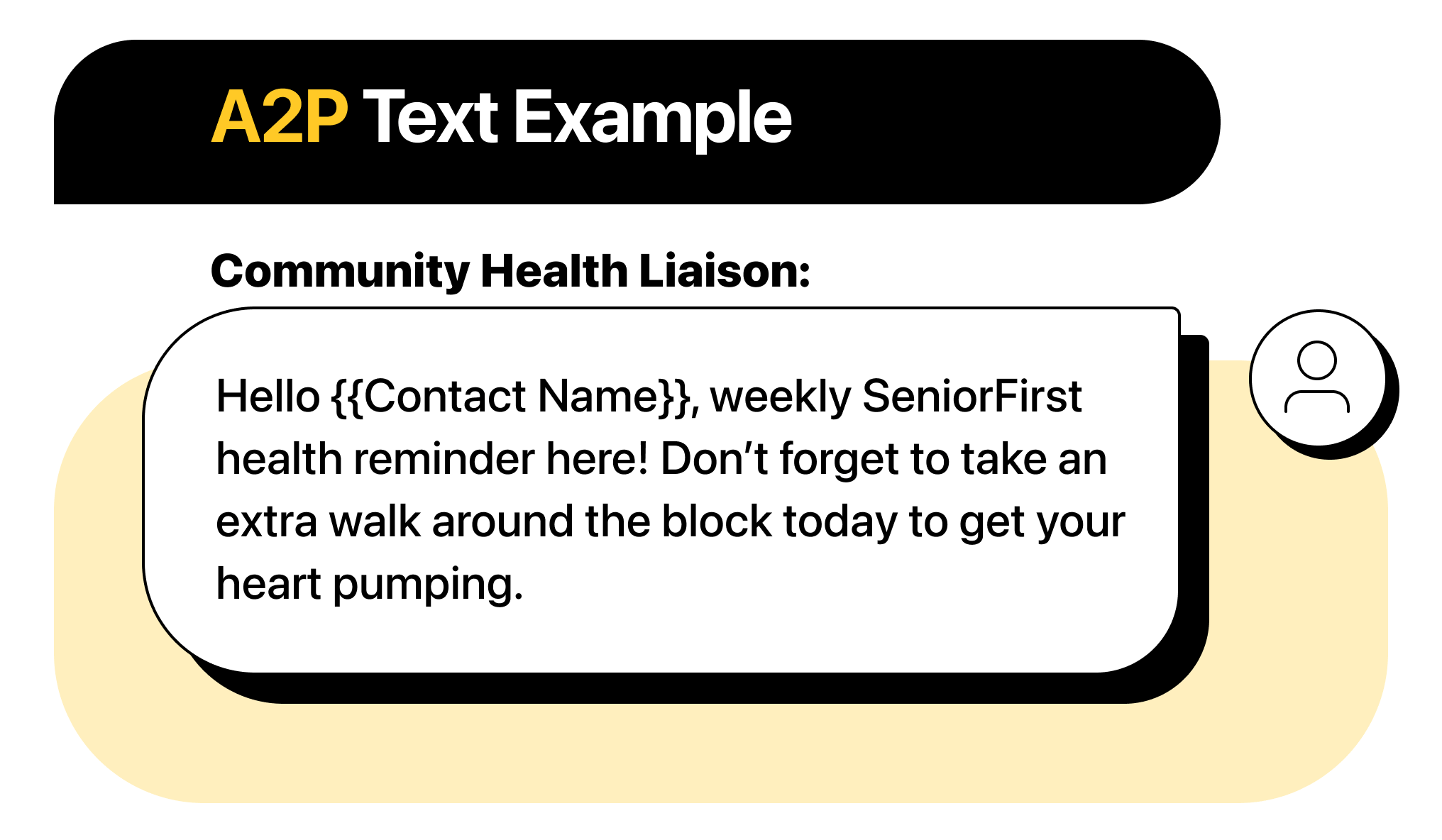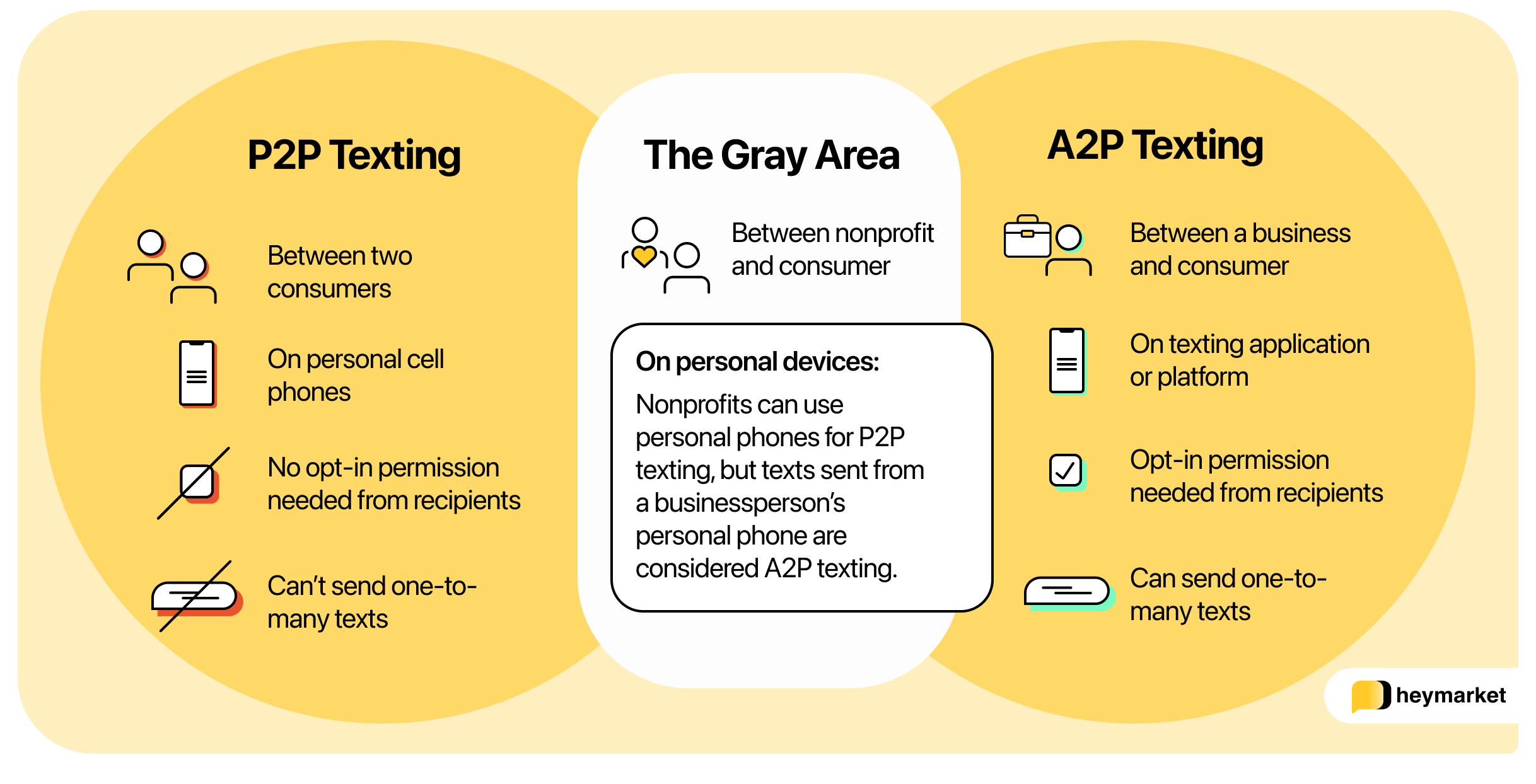
The information contained in this article should not be relied upon as legal advice nor to determine how regulations apply to your use of SMS and our service. This information is provided “as is” and may be updated or changed without notice. You may use this article for your internal reference purposes only.
Whenever you text a friend, family member, or colleague from your personal phone, you’re doing something called P2P texting, which is shorthand for peer-to-peer texting.
As a commercial or nonprofit organization, you might wonder if this kind of texting is allowed between businesses and consumers. The answer can be a little complex—especially for nonprofits.
Let’s explore what P2P texting is, how it compares to a type of business messaging called A2P texting, and whether your organization can—and should—use it.
What Is Peer-to-Peer Texting?
Peer-to-peer texting (also called person-to-person texting) is when two or more people communicate over text message. In the United States and Canada, these people must be two consumers or a nonprofit affiliate (most often a volunteer) and a consumer. They must also be using their personal phones, not a text messaging platform. Professionals in the telecommunications industry refer to peer to peer texting as P2P texting.
Peer-to-peer texting includes:
- A friend texting a friend
- A family member texting a family member
- A volunteer texting a member or contact
- A professional texting a colleague from their cell phone
Other countries consider certain other conversations peer-to-peer texting as well, such as chats between customers and service agents or messages between delivery drivers and order recipients. These countries may allow the use of peer-to-peer texting platforms.
However, in the US and Canada, any conversations between a business and a consumer or conversations that take place through a platform are considered application-to-person texting, or A2P texting.

What is A2P texting?
P2P texting is often defined in contrast to application-to-person texting (A2P texting). In the US and Canada, A2P texting refers to any messages sent through an application or platform. In addition, businesspeople texting consumers about their company (including customer service) is also considered A2P texting.
A2P texting is considered professional or business texting. Organizations use A2P texting to communicate with their leads and customers on a large scale. They share marketing messages, appointment reminders, account alerts, one-time passwords, and more through SMS.
Some A2P platforms allow team members to both send one-to-many texts and reply to incoming messages, having conversations with customers.

Why Is It Important to Understand P2P and A2P?
Understanding what P2P and A2P texting are is important because these classifications determine what rules and regulations an organization could be subject to when they text.
The US and Canadian governments strictly regulate A2P texting, while the guidelines are more nebulous around P2P. Knowing what type of texting your organization uses can help you understand what SMS compliance measures you should be taking.
How do regulators distinguish between P2P and A2P texting?
One key factor that the Federal Communications Commission (FCC) uses to distinguish P2P from A2P is whether the text messages are sent with an automatic telephone dialing system (ATDS). In 2020, the FCC ruled that P2P texting should not be considered autodialing.
A2P Texting Regulations
The US and Canadian governments have stringent guidelines around A2P texting. The Telephone Consumer Protection Act (TCPA) is one of the highest-priority regulations to consider. First enacted in 1991, the TCPA originally restricted telemarketing calls and automatic telephone dialing systems. In 2012, it expanded to include business text messaging.
Here’s a high-level look at what the TCPA requires businesses to do. The company must:
- Provide clear information about its SMS services. When a business lets customers know how to opt in, it must include language about what it intends to send them. For example, in the language around marketing messages, the business must let customers know what these messages will contain and how often they will receive them.
- Ask recipients to opt in before a team member messages them. The TCPA requires businesses to get recipients’ consent before they send them a text. There are different opt-in requirements depending on if the company is sending promotional, informational, or conversational texts.
- Only send the types of texts customers agreed to receive. If customers only signed up for your product updates, do not send them marketing messages.
- Make it easy for recipients to opt out. They must be able to opt out of your texting services by texting in a designated keyword. Common examples include STOP, STOPALL, or ENDALL.
There are other regulations as well, such as 10DLC rules if a company plans on using a regular 10-digit long code (10DLC) phone number instead of a short code. In short, these companies need to register with carriers in order to send texts to larger list sizes.
Businesses who handle electronic protected health information (ePHI) should also consider industry-level regulations, such as the Health Insurance Portability and Accountability Act (HIPAA). For brands engaging in A2P texting, all of these SMS compliance requirements apply.
Are all businesses A2P?
In the case of for-profit businesses, the rules and regulations for A2P texting will apply to them no matter whether they text consumers from personal devices or a business texting platform.
In general, all organizations that send text messages to groups of consumers should use application-to-person texting. But some political and nonprofit organizations use peer-to-peer texting. In this case, they ask volunteers to text contacts through their personal devices. In doing so, they avoid A2P regulations while still capitalizing on texting’s high open rate.
But should these organizations be doing this?
P2P Texting for Nonprofits
There are downsides to P2P texting as a nonprofit. First, volunteers can only message one contact at a time, which can be time-consuming. In addition, nonprofit leaders and managers aren’t able to monitor or record these messages, since they’re sent from personal devices.
Additionally, recipients have no standard way to opt out of P2P messages. For A2P messages, they can text a simple keyword like STOP and the texting platform should automatically remove them. Organizations texting their contacts using personal phones risk texting people who don’t want to receive their messages.
Finally, there’s data to consider. If volunteers text contacts from their personal phones, their organization has no record of these conversations. This becomes important for fundraising because if a volunteer leaves, the organization doesn’t have access to their conversation data to develop those relationships further.
A2P Texting for Nonprofits
Some nonprofits may want to message all of their members or contacts at once, in which case a text service for business makes it easy to send personalized one-to-many messages. Platforms save time and increase deliverability for nonprofits.
Texting from one of these platforms would constitute A2P texting, and nonprofits that use them need to adhere to SMS regulations. These SMS regulations ensure that you’re texting willing participants, often increasing recipient satisfaction and engagement.
Deciding Whether to Text P2P
While for-profit businesses are using A2P texting no matter what. It’s a bit of a gray area for nonprofits. They have a choice between A2P and P2P texting. Before making the decision, consider:

- Is getting an opt-in before texting contacts a barrier? It’s always best to get your recipients to opt in to receive your texts. For A2P texting, it’s required by law. For P2P, organizations should get opt-in even if it’s not explicitly required. You don’t want to text people who aren’t interested in your messages. A2P platforms can help you capture opt ins.
- How important is efficiency? Do you have the time and team members to text contacts one by one? Could you use the time saved by sending one-to-many messages? If efficiency is a priority, an A2P platform can help you broadcast compliant messages.
- Do you want to be able to monitor messages? Are you comfortable with volunteers and staff members sending unmonitored messages? Do you need to keep a record of SMS conversations? If message management is important, an A2P platform can help you keep tabs on texts and conversations.
- What budget are you working with? While having volunteers text from their phones is cost-effective, texting people who have not agreed to being texted can be detrimental to contact relationships. A2P platforms can manage the opt-in process to grow engagement, and some platforms offer nonprofit-specific pricing to organizations that text compliantly.
Answering these questions will help you decide whether P2P texting is right for your organization—or whether an A2P texting platform is worth managing SMS compliance.




